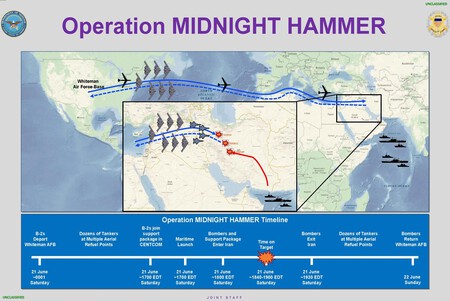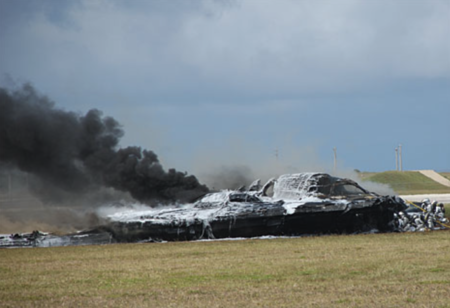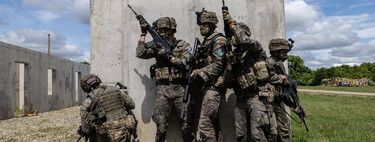He B-2 Spirit It has been used again in a conflict scenario, this time within the framework of an American operation against nuclear facilities in Iran. It does not usually transcend information about its deployment, but this mission has been publicly confirmed. What has come to light allows us to better understand how a bomber is operated that, by design, is designed not to leave their mark.
The mission, baptized as Operation Midnight Hammerwas executed under direct orders of the US president. The objective: attack three Iranian nuclear infrastructure in a coordinated, fast and with the least possible margin possible. As explained by General Dan Caine at a press conference, the main deployment was formed by seven B-2 bombers, which took off from the American continent and flew for more than 18 hours until reaching their goal (about 37 hours in total).

Official Pentagon Diagram showing the B-2 route in the midnight hammer operation against Iran
During that journey, the airplanes made multiple reposses in flight, presumably using KC-135 Stratotanker aircraft, with the support of units that coordinated the operation in several domains: terrestrial, aerial, spatial and cybernetic. The logistics complexity was such that some bombers were diverted to the Pacific as a lure, in a deception effort that only knew a handful of military controls.
Go out without being seen
The main formation crossed the Iranian airspace in complete radio silence, escorted by fourth and fifth generation fighters They cleared the corridor at high speed. The maneuver was backed by different commands – including the US Strategic Command and the Space Command– And it was timed to the second. According to the Pentagon, no enemy shots were recorded during the approach.
Once on the ground, the B-2 attacked Fordow and Natanz, two of the most sensitive enclaves of the Iranian nuclear program. Minutes before, an American submarine had launched more than two dozen Tomahawk missiles to neutralize other defenses and surface structures.
Now, piloting a B-2 in a mission of this type requires more than skill. Require Aguante. They are only two crew on board, in a cabin that – although broader than that of other bombers – is not intended for comfort. They carry suits, helmets, oxygen masks and sit in ejectable seats that have been described as “remarkably uncomfortable” by those who have flown in them.
The rest moments are contemplated: there are times when one can pilot, and the other sleep. As explained to Newsweek Naveed Jamali, a journalist and veteran who witnessed one of the training, the pilots must complete simulations of up to 24 hours to be authorized to participate. The plane has toilet, but not with a full bathroom.
Four key reasons
During his visit to Whiteman Air Force Base, the same journalist interviewed one of those responsible for the unit. He asked what B-2 was unique. The answer was clear: “scope, payload, precision and stealth”That combination, he said, does not offer any other plane in the world. And it is precisely what makes it a critical tool in this type of operations.
Scope, payload, precision and stealth: are the four qualities that make B-2 a practically unmatched bomber.
The B-2 can travel more than 9,600 kilometers without reposting. It can transport up to 20 tons of armament – conventional or nuclear – and is designed to make even the most advanced anti -aircraft systems. It has no direct rivals. And there are only 20 active units.


Image of B-2 while supplying fuel in full flight
It should be noted that the B-2 is also one of the most expensive to operate. Each unit exceeded the 900 million dollars in 1997 (about 1.8 billion dollars in 2025), considering only the acquisition cost with spare parts and support. If the total expenditure of the program – development, maintenance, training and facilities – is included, the figure amounted to about 2,130 million dollars per aircraft in the late 1990s, according to the US government responsibility office (GAO).
The origins of the project date back to the end of the 1970s. In the beginning 132 units were planned. After the end of the cold war and the dissolution of the USSR, that number was cut. In 1992, President George HW Bush limited production to 20 operational units. Years later, the Clinton administration approved to convert an additional prototype – the number 21 – into fully functional aircraft.


The B-2, on stage after the incident recorded in Guam in 2008
Today, however, only 20 active units remain. One was lost in an accident in 2008, shortly after taking off the Andersen base, in Guam. The incident was due to a Anomaly in pressure sensorsaccording to a report of the Air Force Safety Center. It was the first accident of a B-2 and its loss was never replaced.
The B-2 also has another quality that makes it unique: its ability to transport the Massive Ordnance Penetrator (MOP), one of the most powerful bombs ever constructed. It weighs more than 13,000 kilos and is designed to pierce the surface before detonating.


Image from below the B-2: its winging design is no accident
In this operation, that capacity was key. The Secretary of Defense, Pete Hegesh, confirmed that it was the first time that the MOP was used In a real scenarioand that his role was essential to impact facilities deeply buried as Fordow. Although we will have to wait to know the real damage of the operation.

More than 25 years have passed since its entry into service, but the B-2 is still a tool without a rival. Not only for its destructive capacity, but for what it represents: an plane that can cross half planet, dodge defenses and execute a surgical attack without a trace.
Images | Northrop Grumman | Dod Rapid Response | US Ministry of Defense | US Air Force (1, 2, 3, 4)
In WorldOfSoftware | The key between a nuclear and latent nuclear program is the destination of the enriched uranium. And that is a problem for the US











